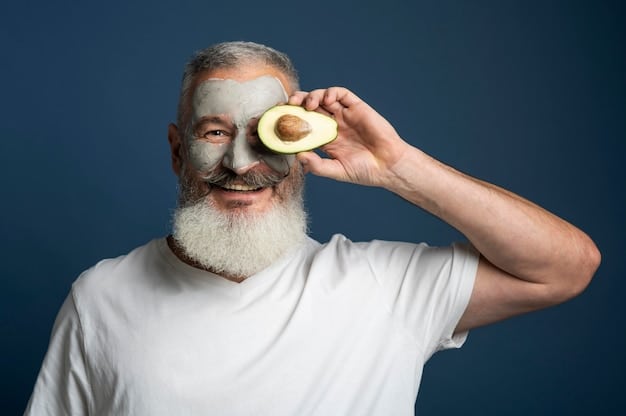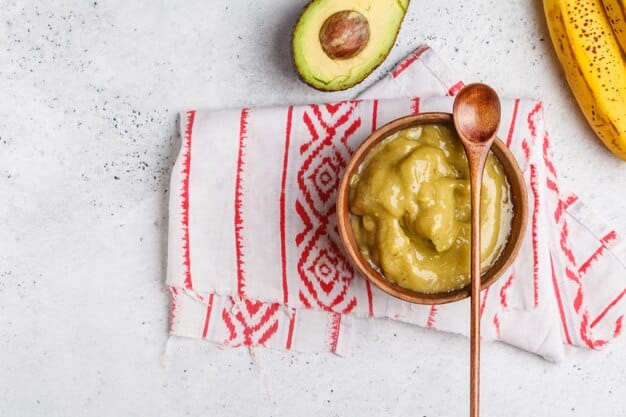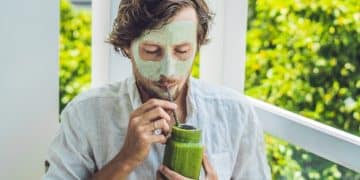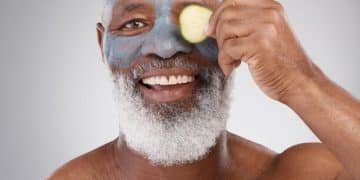DIY Face Masks for Men: 3 Recipes for Clearer Skin

For men seeking practical and effective skincare solutions, creating your own face masks at home from common household ingredients offers a straightforward path to improved skin health, bypassing complex routines with accessible, natural formulations for diverse skin needs.
The pursuit of healthy, vibrant skin is not exclusive to any gender. In fact, more men are recognizing the benefits of a proper skincare regimen. If you’re looking to elevate your routine without breaking the bank or delving into complex chemical formulations, exploring DIY face masks for men: 3 recipes using ingredients you already have is an excellent starting point. These homemade solutions harness the power of natural ingredients, offering targeted benefits for various skin concerns, from oiliness to dryness and sensitivities.
Understanding Men’s Skin: Unique Needs and Challenges
Men’s skin, while sharing fundamental characteristics with women’s, possesses distinct structural and functional differences that influence its needs and how it responds to various treatments. These differences primarily stem from hormonal factors, namely higher levels of testosterone, which lead to features such as greater thickness, increased oil production, and a more robust collagen network. Recognizing these unique attributes is crucial for tailoring effective skincare routines, including the selection and application of face masks.
One of the most notable distinctions is skin thickness. Male skin is, on average, about 20-25% thicker than female skin. This added density is primarily due to a higher collagen content, which contributes to a firmer, more resilient texture. While this can mean men’s skin often shows signs of aging later, it also presents challenges in terms of product penetration. Thicker skin can make it harder for active ingredients to absorb effectively, necessitating formulations that are potent yet gentle enough to work.
Oil Production and Pore Size
Testosterone stimulates the sebaceous glands, leading to higher sebum production in men. This increased oiliness often results in larger pores and a greater propensity for issues like blackheads, whiteheads, and acne breakouts. The oilier nature of male skin means that face masks should often focus on balancing sebum levels, purifying pores, and providing a matte finish without over-drying or stripping the skin of its natural moisture barrier.
- Increased Sebum: Higher testosterone leads to more active sebaceous glands.
- Larger Pores: Often a direct consequence of increased oil production.
- Acne Tendency: Oily conditions create a breeding ground for acne-causing bacteria.
Another significant factor is daily shaving. Shaving can act as a form of exfoliation, but it also subjects the skin to constant mechanical irritation. This can compromise the skin’s protective barrier, leading to redness, razor burn, ingrown hairs, and increased sensitivity. Face masks for men can play a vital role in soothing post-shave irritation, replenishing lost moisture, and aiding in the skin’s recovery process.
The natural pH of men’s skin also tends to be lower (more acidic) compared to women’s. While a slightly acidic pH is beneficial for maintaining the skin’s barrier function and protecting against bacterial overgrowth, imbalances can still occur. Understanding this helps in choosing ingredients that support the skin’s natural balance rather than disrupting it.
Finally, men often have a more developed capillary network, leading to a tendency for increased redness or flushing, especially after physical exertion or exposure to harsh environmental factors. Masks incorporating calming and anti-inflammatory ingredients can be particularly beneficial for managing these concerns.
In summary, while the basic principles of skincare apply universally, the specific physiological makeup of men’s skin demands a tailored approach. Recognizing its thickness, oiliness, shaving-induced sensitivity, and general resilience allows for the development or selection of face masks that genuinely address these unique aspects, promoting healthier and more balanced skin.
The Benefits of DIY Face Masks for Men
In a world saturated with complex skincare products, the simplicity and efficacy of DIY face masks often get overlooked, especially for men. For those seeking a practical, cost-effective, and natural approach to skincare, homemade masks offer a compelling alternative to store-bought options. Harnessing the power of readily available kitchen ingredients, these masks provide tailored benefits that cater specifically to the unique characteristics of men’s skin, from managing oiliness to soothing irritation.
One of the foremost advantages of DIY face masks is complete control over ingredients. Unlike many commercial products that may contain synthetic fragrances, dyes, or preservatives, homemade masks ensure you know exactly what you’re putting on your skin. This transparency is particularly beneficial for men with sensitive skin or those prone to allergic reactions, as it allows for the avoidance of known irritants and the selection of hypoallergenic components.
Cost-Effectiveness and Accessibility
Skincare routines can quickly become an expensive endeavor. High-quality facial products, particularly specialized masks, often come with a significant price tag. DIY face masks, however, utilize ingredients that are typically already present in your pantry, such as oats, honey, fruits, and yogurt. This makes them an incredibly economical choice, allowing for regular skin treatments without financial strain. Moreover, the accessibility of these ingredients means you’re never far from a potential pampering session.
- Budget-Friendly: Uses common, inexpensive household items.
- Readily Available: Ingredients are usually found in most kitchens.
- Sustainability: Reduces reliance on packaged goods and synthetic chemicals.
Many natural ingredients possess powerful anti-inflammatory, antioxidant, and antibacterial properties. For instance, honey is a natural humectant and antiseptic, making it excellent for moisturizing and fighting breakouts. Oatmeal soothes irritation and provides gentle exfoliation. Avocado offers deep hydration and healthy fats, ideal for dry or mature skin. These natural compounds work in harmony with your skin’s biology, promoting healing and balance.
Beyond the physical benefits, the ritual of preparing and applying a DIY face mask can be a surprisingly relaxing and mindful experience. Taking time out to care for your skin provides a moment of self-care, a brief escape from daily stresses. This simple act can contribute to overall well-being, fostering a sense of relaxation and rejuvenation that extends beyond the skin’s surface.
Finally, DIY masks encourage a deeper understanding of your own skin. As you experiment with different ingredients and observe their effects, you begin to learn what works best for your specific skin type and concerns. This personalized approach empowers you to become a more informed participant in your skincare journey, moving away from generic solutions to truly targeted care.
In essence, DIY face masks for men offer a versatile, natural, and beneficial addition to any grooming routine. They provide a responsible, effective, and enjoyable path to achieving healthier, clearer, and more balanced skin, proving that sometimes the best solutions are the simplest ones, found right in your own home.

Recipe 1: The Oily Skin Balancer – Oatmeal & Honey Mask
For men often grappling with excess shine, enlarged pores, and occasional breakouts due to naturally oilier skin, finding a solution that balances sebum production without stripping the skin is key. The Oatmeal & Honey Mask stands out as an effective, soothing, and natural remedy for these common concerns. This simple DIY formulation harnesses ingredients renowned for their gentle yet powerful properties, providing relief and a clearer complexion.
Oatmeal is a cornerstone of this mask due to its exceptional absorbent and anti-inflammatory qualities. Colloidal oatmeal in particular is known to soothe irritated skin, making it ideal for those prone to redness or sensitivity. Its natural saponins act as mild cleansing agents, helping to gently remove impurities and excess oil from the skin’s surface and within pores. Furthermore, its finely ground texture provides a light, physical exfoliation, aiding in the removal of dead skin cells that can clog pores and contribute to a dull complexion.
How Oats and Honey Work Synergistically
Honey, the second star ingredient, is a potent humectant, meaning it draws moisture from the air into the skin, ensuring hydration even as it helps to regulate oil. Beyond its moisturizing capabilities, honey possesses natural antibacterial and antiseptic properties. These attributes are crucial for preventing and managing breakouts, as bacteria often contribute to the formation of acne in oily skin types. Its slight stickiness also helps in lifting impurities from the pores when the mask is rinsed off.
- Antibacterial: Honey helps combat acne-causing bacteria.
- Anti-inflammatory: Oatmeal soothes redness and irritation.
- Oil Absorption: Oats naturally absorb excess sebum.
When combined, oatmeal and honey create a synergistic effect that addresses multiple concerns for oily skin. The mask gently purifies, calms inflammation, absorbs excess oil, and provides essential hydration, all without resorting to harsh chemicals that can strip the skin and trigger even more oil production as a rebound effect.
Recipe Ingredients and Preparation:
- Ingredients:
- Two tablespoons of finely ground plain oatmeal (quick oats work well, or pulse rolled oats in a blender).
- One tablespoon of raw, organic honey.
- A few drops of warm water (or green tea for added antioxidant benefits).
- Preparation:
In a small bowl, combine the ground oatmeal and honey. Gradually add warm water, a few drops at a time, mixing thoroughly until a thick, spreadable paste forms. The consistency should be thick enough to adhere to your face without dripping, but not too stiff.
- Application:
Start with a clean, dry face. Using your fingertips, gently apply an even layer of the mask to your entire face, avoiding the eye and mouth areas. For optimal results, apply after shaving to soothe any potential irritation. Leave the mask on for 15-20 minutes, allowing the ingredients to deeply penetrate and work their magic.
- Removal:
To remove, dampen your fingertips with warm water and gently massage your face in circular motions. This helps to further exfoliate the skin. Rinse thoroughly with lukewarm water until all traces of the mask are gone. Pat your face dry with a clean towel and follow up with a light, non-comedogenic moisturizer to lock in hydration.
Incorporating the Oatmeal & Honey Mask into your routine 1-2 times a week can significantly improve the balance and clarity of oily skin, leaving it feeling fresh, calm, and visibly healthier.
Recipe 2: The Dry Skin Hydrator – Avocado & Banana Mask
For men battling dryness, flakiness, or a tight, uncomfortable sensation, especially after shaving or exposure to harsh environmental elements, the Avocado & Banana Mask offers a rich, nourishing, and deeply hydrating solution. This mask is a powerhouse of natural fats, vitamins, and minerals, designed to replenish moisture, restore the skin’s barrier, and impart a soft, supple feel without leaving a greasy residue. It’s an ideal remedy for skin that craves intense hydration and gentle care.
Avocado is often hailed as a superfood, and its benefits extend beautifully to skincare. Rich in monounsaturated and polyunsaturated fats, including oleic acid, linoleic acid, and alpha-linolenic acid, avocado deeply moisturizes the skin and helps to reinforce its natural lipid barrier. This barrier is crucial for preventing trans-epidermal water loss (TEWL), a common issue in dry skin. Furthermore, avocados are packed with vitamins E and C, powerful antioxidants that protect the skin from environmental damage and support its overall health and elasticity. Vitamin E, in particular, is known for its skin-healing and soothing properties.
The Power Duo: Avocado and Banana for Nourishment
Bananas, the complementary ingredient, are surprisingly beneficial for dry skin. They are rich in potassium, which helps to maintain the skin’s moisture levels, and provide a host of vitamins, including vitamin C and B6, and antioxidants. These components contribute to skin elasticity, smoothness, and protection. The natural sugars in bananas also possess humectant properties, drawing and retaining moisture in the skin, further enhancing the mask’s hydrating capabilities. When mashed, bananas create a smooth, creamy texture that makes the mask easy to apply and highly soothing.
- Deep Hydration: Avocado’s fats replenish moisture.
- Antioxidant Boost: Vitamins E and C protect and heal.
- Barrier Support: Essential fatty acids strengthen skin’s defense.
Together, avocado and banana form a formidable hydrating duo. The mask delivers an intense surge of nourishment, addressing dryness at its core by providing both immediate hydration and long-term barrier support. It leaves skin feeling incredibly soft, supple, and comfortable, diminishing the appearance of dry patches and fine lines caused by dehydration.
Recipe Ingredients and Preparation:
- Ingredients:
- Half a ripe avocado.
- One-quarter of a ripe banana.
- One teaspoon of olive oil (extra virgin for best quality).
- Optional: A few drops of vitamin E oil for extra healing.
- Preparation:
In a small bowl, thoroughly mash the ripe avocado and banana until completely smooth and free of lumps. Add the olive oil and mix well to create a creamy, consistent paste. Ensure there are no large chunks, as this will make application difficult. If desired, mix in a few drops of vitamin E oil.
- Application:
Apply the mask generously to a clean, dry face, paying extra attention to areas prone to dryness like the cheeks and forehead. Avoid the eye area. The mask’s rich texture makes it ideal for a deeper, more indulgent treatment. Leave it on for 20-25 minutes, allowing the skin to absorb all the nourishing benefits.
- Removal:
Gently remove the mask with lukewarm water and a soft washcloth. Rinse thoroughly until all residue is gone. Pat your face dry and revel in the newfound softness. Follow up with your regular moisturizer to seal in the hydration and maintain the supple feel.
Using the Avocado & Banana Mask once a week can transform dry, dull skin into a hydrated, radiant complexion, providing deep comfort and protection against environmental stressors.
Recipe 3: The Sensitive Skin Soother – Yogurt & Aloe Vera Mask
For men with sensitive skin, characterized by redness, irritation, and a tendency to react unfavorably to harsh products, finding a gentle yet effective way to calm and balance the complexion is paramount. The Yogurt & Aloe Vera Mask is a beacon of relief, expertly designed to soothe inflammation, reduce redness, and offer tender hydration using two widely accessible and naturally calming ingredients. This mask provides a benevolent approach to skincare, ensuring comfort and promoting a healthier skin barrier.
Yogurt, particularly plain, unsweetened varieties, is a phenomenal ingredient for sensitive skin. It contains lactic acid, a mild Alpha Hydroxy Acid (AHA) that provides gentle exfoliation, helping to remove dead skin cells without causing irritation. More importantly, yogurt is rich in probiotics, which can help strengthen the skin’s microbiome, enhancing its natural barrier function and reducing susceptibility to external aggressors. Its cooling properties also offer immediate relief to inflamed or hot skin, making it excellent for post-shave irritation or general redness.
Aloe Vera: Nature’s Calming Elixir
Aloe vera, a succulent plant renowned for its medicinal properties, is arguably one of nature’s most effective soothing agents. Its gel is packed with vitamins (A, C, E, B12), enzymes, minerals, and amino acids, all of which contribute to its anti-inflammatory, antioxidant, and healing capabilities. For sensitive skin, aloe vera works wonders by reducing redness, alleviating itching, and promoting tissue repair. It provides deep, non-greasy hydration, which is essential for maintaining the integrity of a compromised skin barrier.
- Anti-inflammatory: Aloe vera calms redness and irritation.
- Probiotic Support: Yogurt helps strengthen skin’s natural defenses.
- Gentle Exfoliation: Lactic acid in yogurt smooths skin without harshness.
When combined, yogurt and aloe vera create a powerful yet incredibly gentle mask. The probiotics and mild exfoliation from the yogurt complement the profound soothing and healing effects of aloe vera, addressing the root causes of sensitivity while delivering ample moisture. This combination offers a holistic approach to calming reactive skin, leaving it feeling balanced, comfortable, and visibly less irritated.
Recipe Ingredients and Preparation:
- Ingredients:
- Two tablespoons of plain, unsweetened yogurt (full-fat for extra moisture).
- One tablespoon of pure aloe vera gel (from a fresh leaf or pure bottled gel).
- Optional: A few drops of chamomile tea (cooled) for added calming.
- Preparation:
In a small bowl, mix the plain yogurt and aloe vera gel thoroughly until well combined and smooth. If using, add a few drops of cooled chamomile tea. The consistency should be easy to spread but not too runny. Ensure the aloe vera gel is pure, as some commercial gels contain alcohol or fragrances that could irritate sensitive skin.
- Application:
Apply the mask to a clean, dry face using your fingertips or a soft brush. Be gentle, particularly if your skin is already inflamed. Pay attention to areas where you experience the most redness or discomfort, such as the cheeks or jawline (common post-shave irritation zones). Allow the mask to sit for 15-20 minutes, giving the ingredients sufficient time to work their calming magic.
- Removal:
Remove the mask gently with lukewarm water and a very soft cloth or just your hands, avoiding any harsh scrubbing. Rinse thoroughly until all residue is gone. Pat your face dry with a clean, soft towel. Follow with a fragrance-free, gentle moisturizer to lock in the soothing benefits and protect your newly calm skin.
Regular use of the Yogurt & Aloe Vera Mask (1-2 times a week) can significantly reduce sensitivity, improve skin resilience, and leave your complexion feeling harmonized and comfortable.
Tips for Maximizing Your DIY Mask Experience
Creating and applying DIY face masks is more than just mixing ingredients; it’s an opportunity to create a personalized skincare ritual that benefits your skin and your overall well-being. To truly maximize the effectiveness and enjoyment of your homemade mask experience, a few strategic tips can make a significant difference. These insights extend beyond the simple application, ensuring you get the most out of every natural concoction.
Preparation is Key
Before you even begin mixing your ingredients, ensure your skin is perfectly prepped. A clean slate is essential for optimal absorption. Always start by thoroughly cleansing your face with a gentle cleanser suitable for your skin type. This removes dirt, oil, and any makeup, allowing the mask’s nutrients to penetrate more deeply and work more effectively. Additionally, consider a warm compress or a quick steam over a bowl of hot water for a few minutes. This gentle warmth helps to open up your pores, further enhancing the absorption of the mask’s beneficial compounds.
- Cleanse First: Ensure skin is free of impurities.
- Open Pores: Use steam or a warm compress for better absorption.
- Patch Test: Always test new ingredients on a small skin area.
When preparing your mask, opt for fresh, high-quality ingredients. Just as you would for dietary consumption, the fresher the ingredients, the more potent their beneficial properties will be. For instance, using ripe avocado or fresh aloe vera gel directly from the plant will yield better results than older, less vibrant versions of the same ingredients. Pay attention to the consistency of your mask. It should be thick enough to stay on your face without dripping, but still spreadable. Adjust the liquid component (water, tea, or milk) as needed to achieve the ideal texture.
An often-overlooked step for DIY masks, particularly if you have sensitive skin or are trying a new ingredient, is a patch test. Apply a small amount of the prepared mask to an inconspicuous area of your skin, like behind your ear or on your inner forearm. Wait 24 hours to check for any signs of irritation, redness, or itching. This simple precaution can prevent a full-face reaction and ensure your masking experience is positive.
During application, uniformity is important. Apply an even layer of the mask across your entire face, avoiding the delicate eye and lip areas. Use clean fingertips or a dedicated, soft mask brush for hygienic and even distribution. Take this time to gently massage the mask into your skin, stimulating circulation and ensuring good contact. While the mask is on, resist the urge to talk, chew, or make excessive facial expressions, as this can crack the mask and potentially pull on your skin, especially with drying masks.
Finally, consistency is paramount. While DIY masks are wonderful, they are not a one-time miracle cure. Incorporate them into your routine 1-2 times a week, depending on your skin’s needs and the specific mask type. Regular application allows the beneficial ingredients to work accumulatively, supporting long-term skin health and noticeable improvements. Listen to your skin; if a particular ingredient causes discomfort, simply adjust your recipe or try another.
By following these tips, you can transform your DIY masking sessions from a simple treatment into a truly effective and enjoyable self-care ritual, leading to healthier, more radiant skin.
Beyond the Face: Integrating Skincare into Your Lifestyle
While the focus on DIY face masks offers an excellent starting point for improving skin health, truly radiant and resilient skin is a reflection of a holistic approach to well-being. Beyond localized treatments, integrating broader skincare principles into your daily lifestyle can significantly amplify results and contribute to overall health. This involves a conscious effort to nourish your body from the inside out, protect your skin from external aggressors, and establish consistent habits that support its natural functions.
Nutrition and Hydration: Fueling Your Skin from Within
The adage “you are what you eat” holds profound truth when it comes to skin health. A balanced diet rich in antioxidants, healthy fats, vitamins, and minerals is fundamental. Incorporate plenty of fruits, vegetables, lean proteins, and whole grains into your meals. Foods high in omega-3 fatty acids, such as salmon, flaxseeds, and walnuts, are particularly beneficial, as they help to reduce inflammation and maintain the skin’s lipid barrier, leading to a more supple and hydrated complexion. Conversely, limiting processed foods, excessive sugar, and unhealthy fats can prevent inflammation that often manifests as breakouts or dullness.
- Dietary Choices: Focus on antioxidant-rich foods and healthy fats.
- Water Intake: Crucial for maintaining skin elasticity and preventing dryness.
- Quality Sleep: Allows skin cells to repair and regenerate effectively.
Hydration is equally critical. Drinking an adequate amount of water throughout the day is non-negotiable for vibrant skin. Water helps to flush out toxins, deliver nutrients to skin cells, and maintain skin elasticity. Dehydration can quickly lead to dry, flaky, and dull skin, making any topical treatment less effective. Aim for at least eight glasses of water daily, and more if you are physically active or in a hot climate.
Adequate sleep is another cornerstone of a healthy complexion. During sleep, your body enters a repair mode, and your skin is no exception. Cells regenerate, collagen production increases, and blood flow to the skin improves. Chronic sleep deprivation can lead to dullness, dark circles, and exacerbate existing skin conditions. Prioritizing 7-9 hours of quality sleep each night allows your skin to perform its essential restorative processes.
Stress management also plays a vital role. High stress levels trigger hormonal responses that can lead to increased oil production, breakouts, and conditions like eczema or psoriasis. Incorporating stress-reducing activities, such as meditation, yoga, regular exercise, or spending time in nature, can significantly mitigate these negative effects on your skin.
Finally, sun protection is paramount. UV radiation is arguably the single most damaging external factor for skin, leading to premature aging, hyperpigmentation, and an increased risk of skin cancer. Make it a daily habit to apply a broad-spectrum sunscreen with an SPF of 30 or higher, even on cloudy days. Combine this with protective clothing and seeking shade during peak sun hours.
By consciously integrating these lifestyle habits—nutritious eating, ample hydration, quality sleep, stress management, and daily sun protection—you build a robust foundation for healthy skin. Face masks, whether DIY or commercial, then act as powerful enhancements to this underlying health, ensuring your skin looks and feels its best.
Troubleshooting Common Masking Issues for Men
While DIY face masks offer a straightforward and effective way to address various skin concerns, occasional issues can arise that might hinder the desired results or cause mild discomfort. For men incorporating these routines, understanding common problems and their simple solutions is key to ensuring a consistently positive and beneficial masking experience. Troubleshooting allows you to fine-tune your approach, guaranteeing your homemade remedies work optimally for your unique skin.
Irritation or Redness After Mask Application
One of the most common issues, particularly for sensitive skin types or when trying new ingredients, is post-mask irritation or redness. This can sometimes be due to an allergic reaction to a specific ingredient, or simply an ingredient being too potent for your skin. The first step in troubleshooting is to always perform a patch test on a small, inconspicuous area of your skin (like behind the ear or on your inner forearm) at least 24 hours before applying the mask to your entire face. If irritation occurs during the patch test, avoid that particular ingredient.
- Perform a Patch Test: Essential for identifying potential irritants.
- Adjust Ingredient Ratios: Reduce concentration if too potent.
- Opt for Softer Ingredients: Choose known gentle components like aloe vera or oatmeal.
If irritation occurs during or after using a mask that previously seemed fine, consider if the ingredient ratios were too strong. For instance, too much lemon juice can be overly acidic. Reduce the concentration of potentially active ingredients, or dilute the mask with more neutral components like plain yogurt or milk. Also, ensure you’re not leaving the mask on for too long; adhering to the recommended application time is important. If persistent irritation occurs, it’s wise to consult a dermatologist.
Another frequent concern is a lack of noticeable results. This could stem from several factors. Firstly, consistency is vital. A single application of a DIY mask, while immediately refreshing, won’t magically solve long-standing skin issues. Regular use, typically 1-2 times a week over several weeks, is often necessary to see significant improvements. Secondly, ensure the mask is adequately addressing your specific skin concern. An avocado mask is great for dryness, but less effective for controlling extreme oiliness.
Sometimes, masks don’t apply or remove cleanly. If your mask is too runny, it will drip, making a mess and potentially irritating your eyes. To fix this, gradually add a thickening agent like more ground oatmeal, clay, or a little more mashed fruit until you achieve a spreadable, non-drippy consistency. If the mask is too thick or crumbles, it might be difficult to spread evenly and will dry out too quickly. Add a few drops of water, milk, or a liquid oil (like olive oil) to thin it out.
For removal, if the mask seems stuck or leaves residue, dampen your face with warm water first and gently massage the mask to loosen it. Using a soft, damp washcloth can also aid in removal. Avoid harsh scrubbing, as this can irritate the skin, especially after a mask.
By proactively addressing these common challenges, men can ensure their DIY face mask regimen remains a beneficial, enjoyable, and effective component of their overall skincare routine, yielding the clear, healthy skin they desire.
| Key Benefit | Target Skin Concern |
|---|---|
| ✨ Oil Control & Soothing | Oily skin, breakouts, mild irritation. |
| 🥑 Deep Hydration & Nourishment | Dry, flaky, tight skin, fine lines due to dehydration. |
| 🌿 Calming & Barrier Support | Sensitive skin, redness, post-shave irritation. |
| 💰 Cost-Effective & Natural | Budget-conscious skincare, preference for natural ingredients. |
Frequently Asked Questions About DIY Face Masks for Men
For most men, using DIY face masks 1-2 times a week is generally sufficient. Oily or acne-prone skin might benefit from more frequent application, like every other day, if the mask contains gentle ingredients. Dry or sensitive skin may only need a weekly treatment. Always observe your skin’s reaction and adjust accordingly to avoid over-treatment or irritation, ensuring optimal benefits.
Yes, certain DIY face mask ingredients can be highly beneficial for razor burn and ingrown hairs. Ingredients like aloe vera and oatmeal, found in the Sensitive Skin Soother mask, possess strong anti-inflammatory and soothing properties that help calm irritated skin. Their gentle nature can reduce redness and discomfort associated with shaving, promoting healthier post-shave skin recovery and minimizing irritation.
While the provided recipes target oily, dry, and sensitive skin types specifically, the ingredients themselves are generally mild. However, individual skin reactions can vary. It’s crucial to perform a patch test before applying any new DIY mask to your entire face, especially if you have highly reactive or allergy-prone skin. This precaution helps prevent potential irritation or adverse reactions.
DIY face masks, made with fresh, perishable ingredients, generally have a very limited shelf life. It is strongly recommended to prepare only enough for a single application. If you have any leftovers, they should be stored in an airtight container in the refrigerator and ideally used within 24 hours. Beyond this, the ingredients can spoil, harbor bacteria, and lose their efficacy, potentially harming your skin.
To apply a DIY mask, ensure your face is clean and dry. Use clean fingertips or a soft, dedicated mask brush to spread an even layer, avoiding the eye and mouth areas. For removal, dampen your face with lukewarm water, gently massaging the mask to loosen it, especially if it has dried. Rinse thoroughly with lukewarm water until all mask residue is gone, then pat your skin dry with a clean towel.
Conclusion
Embracing the world of DIY face masks offers men a pragmatic, natural, and highly effective pathway to healthier skin, bypassing the complexities of commercial products. By leveraging common household ingredients, these three recipes—Oatmeal & Honey for oily skin, Avocado & Banana for dry skin, and Yogurt & Aloe Vera for sensitive skin—provide tailored solutions that address unique concerns while promoting overall skin balance and vitality. Integrating these simple yet powerful treatments, combined with a holistic approach to lifestyle and consistent application, empowers men to achieve and maintain a complexion that not only looks good but genuinely feels good, reinforcing the understanding that effective skincare can indeed be both accessible and profoundly beneficial.





